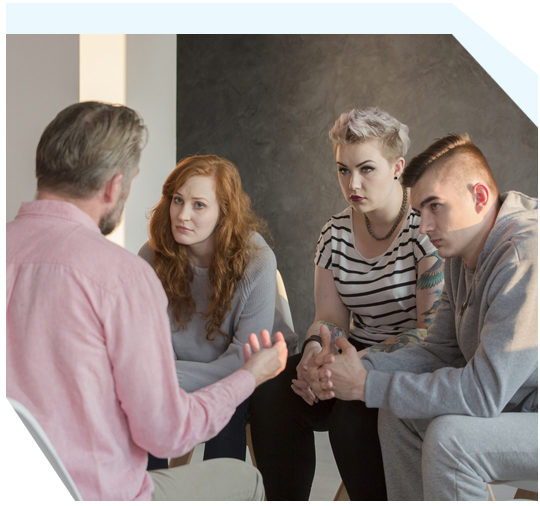Inpatient Drug
Rehab Near Me
in Cockeysville Maryland
What is an Inpatient Drug Rehab
Treatment Program?
Inpatient drug rehab is a type of treatment program wherein the patient resides in a rehab facility for the duration of the treatment. There, they will receive round-the-clock care under a structured program.
Residential or inpatient rehab means staying in the facility 24/7. Patients are supervised by medical professionals who provide continuous care and assistance. Addiction treatment patients may board with an assigned roommate or stay in a room alone. Inpatient treatment involves a lot of scheduled one-on-one and group therapy sessions.
One of the biggest benefits of inpatient drug rehab treatment is that it separates patients from their usual environment. Residential addiction treatment keeps them away from their triggers and temptations. Some addiction treatment patients have problematic home environments, and distancing them from it can help them in their recovery. LEARN MORE
Inpatient Addiction
Treatment: What Happens
in Drug Rehab Programs?
Inpatient drug rehab is just an umbrella term for the many kinds of treatment programs that are done in a residential setting. The actual experience patients have in an inpatient rehab depends on the program they attend. The only thing that’s consistent across all these different programs is that patients will stay in their facility full-time throughout the treatment. LEARN MORE


Do I Need Residential
Drug and Alcohol
Rehab?
The appropriate type of treatment for one person may not be right for another. But the benefits of residential drug recovery are clear. If you need another environment to focus on getting sober, this is the kind of program for you. LEARN MORE
Do I Need Medical Detox
at a Treatment Center?
Medical detox is necessary for dealing with addiction because substance abuse causes dependence. The medical care you get when detoxing with trained medical staff is far superior than trying to detox at home. During drug or alcohol abuse, the person develops a tolerance for the substance, LEARN MORE


The Effects of Drug
Abuse and Addiction
Substance use disorders like drug abuse or alcohol abuse often lead to addiction, and this is why inpatient rehab programs are necessary. Substance use disorder or SUD is caused by the continuous intake of certain substances such as alcohol, opioids, marijuana, hallucinogens, etc. LEARN MORE
How Do I Find an Inpatient
Drug Rehab Center
Near Me?
While there are certain criteria that can determine the right treatment for you, there are other factors you need to consider before choosing the right treatment center. You can always search online for a rehab center or recovery facilities near you. If you have insurance, LEARN MORE

What is the Difference between Inpatient &
Outpatient Rehab For Drug Addiction Treatment?
Inpatient treatment, also known as residential drug rehab, involves staying in a rehab facility for the duration of treatment. Outpatient treatment is less structured and less focused, but it allows the patient to leave the facility to stay at home. Patients can return to their regular life in between sessions.
What is a Day Like at an Inpatient
Rehab Center?
Inpatient drug and alcohol treatment facilities offer different amenities. But they all provide meals, a room to sleep in, regular therapy sessions, and continuous medical support. In the morning, patients rise early—this is part of the inpatient program because it helps build discipline. LEARN MORE
Things to Look for When
Choosing Inpatient Rehab Centers
Once you’re ready to enter an inpatient program, you have to select the right facility for you. Sometimes, it’s just a matter of location and where you’re able to get the best treatment that’s not too far away. But we have also listed a few questions that clients need to ask before settling on the right rehab facility.
What Type of Substance Abuse Disorders
Does Residential Rehab Treat?
When choosing a residential facility, first you need to look at the kinds of programs they are offering. They may treat a wide variety of substances, but the exact programs and therapies may vary. Some facilities specialize in treating certain types of addictions. Some are focused on alcohol abuse, for example. LEARN MORE
About Cockeysville
Rehab Treatments In Cockeysville Maryland
- Alcohol Addiction Cockeysville
- Alcohol Detox Cockeysville
- Alcohol Rehab Cockeysville
- Alcohol Rehab for Veterans Cockeysville
- Finding the Best Alcoholism Rehab Near Me in Cockeysville
- AA Free & Confidential Alcoholics Anonymous Helpline Cockeysville
- Benzodiazepines Rehab Near Me Cockeysville
- Christian Drug Rehab Cockeysville
- Drug Rehab-addiction Treatment Centers Near You Cockeysville
- Dual Diagnosis Treatment Centers Near You Cockeysville
- (EAP) Employee Assistance Programs Cockeysville
- Fentanyl Cockeysville
- Find 30-Day Inpatient Drug Rehabs Near You! Cockeysville
- Find 60 Day Inpatient Drug Rehabs Near You! Cockeysville
- Find 90 Day Inpatient Drug Rehabs Near You! Cockeysville
- Hydrocodone Cockeysville
- Inpatient Drug and Alcohol Rehab Near Me Cockeysville
- Inpatient Drug Rehab Treatment Program Cockeysville
- Luxury Drug & Alcohol Addiction Treatment Centers Cockeysville
- Mental Health, Addiction, and Drug Rehab Cockeysville
- NA Hotline, Narcotics Anonymous 24 Hour Hotline Cockeysville
- Online Therapy|Mental Health|Substance Abuse|Dual Diagnosis Cockeysville
- Mental Health Online Therapy | Teletheraphy Cockeysville
- Outpatient Drug Rehab Near Me Cockeysville
- Oxymorphone Cockeysville
- Prescription Drugs Cockeysville
- Student Drug Rehab Cockeysville
About Maryland
Browse by State
- ALABAMA
- ALASKA
- ARIZONA
- ARKANSAS
- CALIFORNIA
- COLORADO
- CONNECTICUT
- DELAWARE
- FLORIDA
- GEORGIA
- HAWAII
- IDAHO
- ILLINOIS
- INDIANA
- IOWA
- KANSAS
- KENTUCKY
- LOUISIANA
- MAINE
- MARYLAND
- MASSACHUSETTS
- MICHIGAN
- MINNESOTA
- MISSISSIPPI
- MISSOURI
- MONTANA
- NEBRASKA
- NEVADA
- NEW HAMPSHIRE
- NEW JERSEY
- NEW MEXICO
- NEW YORK
- NORTH CAROLINA
- NORTH DAKOTA
- OHIO
- OKLAHOMA
- OREGON
- PENNSYLVANIA
- RHODE ISLAND
- SOUTH CAROLINA
- SOUTH DAKOTA
- TENNESSEE
- TEXAS
- UTAH
- VERMONT
- VIRGINIA
- WASHINGTON
- WEST VIRGINIA
- WISCONSIN
- WYOMING

